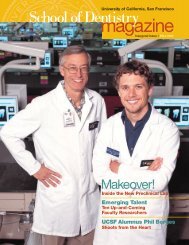Acknowledgements - UCSF School of Dentistry - University of ...
Acknowledgements - UCSF School of Dentistry - University of ...
Acknowledgements - UCSF School of Dentistry - University of ...
Create successful ePaper yourself
Turn your PDF publications into a flip-book with our unique Google optimized e-Paper software.
#38 Title: Death Note against OSCC<br />
F YANG (1), W XIAO (2), R LIU (2), R KRAMER (1), K LAM (2)<br />
(1) <strong>UCSF</strong> <strong>School</strong> <strong>of</strong> <strong>Dentistry</strong>; (2) UC Davis Medical Center Department <strong>of</strong> Biochemistry<br />
Background: Oral squamous cell carcinoma (OSCC) is a well-known malignancy that accounts for more than 90% <strong>of</strong> all oral<br />
cancers. 5-years survival rates for OSCC decrease with delayed diagnosis. So far, there is no sensitive and specific clinical<br />
screening method for OSCC . We therefore investigate a less invasive but more specific and sensitive method for screening OSCC.<br />
Objective: Our goal is to find ligands that will specifically bind to OSCC cells but not to normal healthy oral cells for clinical<br />
screening and subsequent treatment.<br />
Method: In this study, we employed “one bead one compound” combinatorial library (OBOC) strategy to identify specific ligands for<br />
OSCC. Briefly, 24 random libraries were screened with OSCC derived from lateral side <strong>of</strong> tongue for 1.5 hrs to identify library with<br />
possible OSCC binding ability. One library named X1 with strong, and fast OSCC binding property was chosen for further study.<br />
The selected libr ary has a permutation <strong>of</strong> 24.3 million compounds. Live OSCC were co-cultured with X1 OBOC libraries for 1.5 hrs.<br />
These OSCC cell binding beads were isolated and co-cultured with normal keratinocytes derived from skin. Compound beads that<br />
showed strong binding to OSCC but not to normal keratinocytes were identified. The chemical structures <strong>of</strong> the compounds were<br />
determined using Edmund Chemistry.<br />
Results: A final <strong>of</strong> 12 beads with strong OSCC binding, but no keratinocyte binding ability were identified and a motif was observed.<br />
Conclusion: Current work is underway to evaluate these ligands’ cytotoxicity, and possible conjugation to imaging agents for visual<br />
inspection <strong>of</strong> OSCC in vitro. In the future, these OSCC cell binding ligands will be reserved and generated on “one bead two<br />
compound” libraries to induce apoptosis <strong>of</strong> OSCC.<br />
III. POSTDOCTURAL/RESIDENT CATEGORY<br />
#39 Title: “Meth Mouth”: The Effect <strong>of</strong> Drug-Use Patterns, Beliefs, and Knowledge<br />
R BROWN-KIMBREW<br />
<strong>UCSF</strong> Department <strong>of</strong> Preventive and Restorative Health Sciences<br />
Objectives: Rampant dental caries, “meth mouth,” is characteristic <strong>of</strong> methamphetamine use; the second most widely abused drug<br />
in the world. The author sought to investigate the impact <strong>of</strong> drug-use patterns and knowledge on “meth mouth” severity and<br />
compared the number <strong>of</strong> teeth affected by caries between methamphetamine users (MA users) and nonusers using the DMFT<br />
(decayed, missing and filled teeth) index.<br />
Methods: A case-control study design was used amongst voluntary participants at the Sonoma County Main Adult Detention<br />
Facility. A sample <strong>of</strong> 59 MA users and 40 nonusers completed a self-administered questionnaire to assess their dental health, druguse<br />
patterns, and knowledge <strong>of</strong> “meth mouth.” Oral examinations were performed to obtain a DMFT index for each cohort. The data<br />
was analyzed using descriptive statistics, t-tests and analysis <strong>of</strong> variance.<br />
Results: MA users had higher DMFT scores (p=0.019) than nonusers and perceived that their oral health had declined (p=0.000)<br />
since using. Two drug-use patterns, years <strong>of</strong> use (p=0.026) and dosage (p=0.031), impacted DMFT and missing scores,<br />
respectively. Few participants<br />
(6.1 percent) had received “meth mouth” information from dental pr<strong>of</strong>essionals.<br />
Conclusions: MA users have more permanent teeth affected by dental caries and the years <strong>of</strong> use and the dosage impacts the<br />
severity <strong>of</strong> “meth mouth”. Dentists should consider methamphetamine abuse among patients with high DMFT scores and provide all<br />
patients with information about “meth mouth” to prevent future or continued use <strong>of</strong> this drug.<br />
#40 Title: Effect <strong>of</strong> hydrogel Modulus and RGD Ligand Density on Mesenchymal Stem Cell Proliferation and Differentiation<br />
A JANG (1) A JHA (2), E CHEUNG (2), K HEALY (2)(3)<br />
(1) <strong>UCSF</strong> Department <strong>of</strong> Preventive and Restorative Dental Sciences (2) UC Berkeley Department <strong>of</strong> Bioengineering (3) UC<br />
Berkeley Department <strong>of</strong> Materials Science and Engineering<br />
Background: Mesenchymal stem cells (MSCs) carry the potential to differentiate into multiple tissue types including osteoblasts,<br />
chondrocytes, and adipocytes. These cells hold great promise for the regeneration <strong>of</strong> orthopedic joints including the periodontium.<br />
Self-renewal and differentiation <strong>of</strong> these cells are thought to be directed, in part, by biomechanical microenvironment features <strong>of</strong> the<br />
surrounding extracellular matrix (ECM).<br />
Objectives: In this study, we report on a synthetic ECM system which is independently tunable for cell adhesion ligand presentation<br />
and matrix stiffness for the purposes <strong>of</strong> guiding MSC proliferation and differentiation towards an osteoblastic state.<br />
Methods: A semi interpenetrating network (sIPN) hydrogel containing p(N-isopropylacrylamide-co-AAc) was synthesized using a<br />
radical addition reaction. Variation <strong>of</strong> crosslinking agent and polyacrylic acid-graft-[RGD] peptide concentration allowed for the<br />
independent tuning <strong>of</strong> complex modulus and cell adhesion ligand presentation. A custom QPQGLAK diacrylate crosslinking agent<br />
was utilized to facilitate osteoblastic differentiation by providing MMP-13 cleavage sites. Complex modulus was determined using<br />
rheology. Responses <strong>of</strong> both rat mesenchymal stem cells (rMSCs) and human mesenchymal stem cells (hMSCs) were<br />
<strong>School</strong> <strong>of</strong> <strong>Dentistry</strong> Research and Clinical Excellence Day 2011 Program 18




